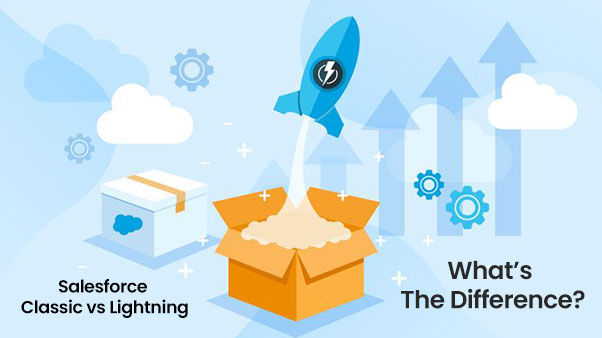Salesforce Classic vs Lightning: What’s the Difference?
- Neha Gharpande
- Dec 24, 2024
- 3 min read
For businesses using Salesforce, understanding the difference between Salesforce Classic vs Lightning is about productivity, flexibility, and future-proofing your CRM.

What Is Salesforce Classic?
Salesforce Classic is the original user interface (UI) that powered Salesforce for years. It features:
A simple, text-based layout
Basic dashboards and reports
Limited customization through Visualforce pages and page layouts
For businesses using Salesforce, understanding the difference between Classic and Lightning is about productivity, flexibility, and future-proofing your CRM.
Classic is reliable and familiar, especially for users who have been working with Salesforce for a long time. However, it lacks modern design, productivity features, and the flexibility today’s businesses need.

What Is Salesforce Lightning?
Salesforce Lightning (also called Lightning Experience) is the modern UI designed to boost user productivity and make Salesforce more customizable and engaging.
Launched in 2015, Lightning includes:
Drag-and-drop components via Lightning App Builder
Advanced dashboards and interactive charts
Lightning Web Components (LWC) for developers
Improved mobile experience
AI-powered tools like Einstein
Lightning focuses on user experience, flexibility, and helping businesses build apps faster.

Key Differences: Salesforce Classic vs Lightning
Here’s a side-by-side comparison to help you see what sets them apart:
Feature / Aspect | Salesforce Classic | Salesforce Lightning |
User Interface (UI) | Older, text-heavy, minimal styling; more like traditional web apps | Modern, dynamic UI with cards, components, and responsive design |
Customization | Limited customization through Visualforce pages and page layouts | Highly customizable using Lightning App Builder, components, and drag-and-drop |
Development Model | Primarily Visualforce and Apex | Lightning Web Components (LWC), Aura components, App Builder, plus Visualforce |
Productivity Tools | Basic list views and dashboards | Enhanced list views, Kanban boards, Path, Einstein AI, and advanced dashboards |
Home Page | Static, same for everyone | Customizable per user, role, or profile with components like news, tasks, and charts |
Reports & Dashboards | Standard reporting; fewer visualization options | Better visuals, interactive charts, and filters |
Mobile Experience | Not fully optimized; relies on Salesforce1 app | Fully responsive and built for seamless mobile experience |
Einstein AI | Limited or no AI features | Access to AI tools like Einstein Opportunity Scoring and Predictions |
User Adoption | Familiar to long-time users, but dated look | Modern, user-friendly; designed to improve adoption and productivity |
Future Development | Limited enhancements; mostly maintenance | Ongoing innovation, new features released by Salesforce only for Lightning |
Why Move to Salesforce Lightning?
Salesforce Classic still works—but it isn’t getting new features. Here’s why thousands of organizations are moving to Lightning:
Modern User Experience: Easier navigation, better visuals, and faster adoption.
Customization: Build pages tailored to roles or teams without code.
AI & Automation: Leverage Einstein for smarter sales, service, and marketing.
Better Reporting: Advanced dashboards, real-time insights, and filters.
Mobile-First: Consistent experience across desktop, tablet, and mobile.
Continuous Innovation: New Salesforce features are released only for Lightning.
How to Switch from Classic to Lightning
Moving to Lightning takes planning, but it unlocks huge value. Here’s a simplified process:
Readiness Check: Use the Salesforce Lightning Experience Readiness Report to see what needs updating.
Define Use Cases: Identify critical processes and customizations to migrate.
Redesign Pages: Use Lightning App Builder to customize pages.
Test & Pilot: Launch a pilot group to gather feedback.
Train Users: Offer training sessions and resources to boost adoption.
Go Live: Roll out in stages, monitor, and optimize.
Tip: Work with a certified Salesforce partner to ensure a smooth migration.
Real-World Example
A global manufacturing company migrated from Classic to Lightning and:
Reduced data entry time by 25%
Increased sales pipeline visibility through dynamic dashboards
Empowered reps to manage opportunities on mobile during site visits
The move wasn’t just about new UI; it changed how teams worked every day.
Final Thoughts
The difference between Salesforce Classic and Lightning is more than just design. Lightning brings:
1. Modern UX
2. Customizable pages
3. AI tools
4. Mobile-first design
5. Faster innovation
If your organization still uses Classic, now is the time to explore the benefits of Lightning and switch to productivity, efficiency, and smarter workflows with CSL.
Ready to make the switch to Salesforce Lightning?
Partner with Cloud Science Labs to plan a smooth migration, empower your teams, and take full advantage of Lightning’s productivity, customization, and AI-driven insights.




Comments